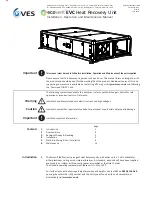
How the System Works
A Brief Word About Infrared
Infrared is a light ray that is below the visible light spectrum,
just like the sound spectrum extends beyond your hearing
ability. An example of infrared transmission: is the remote
control for your TV set. A beam of infrared light is emitted by a
Light Emitting Diode (LED) from the remote control and it is
detected by a receiving diode in your TV set. When you push a
certain command on your control, the internal electronics
causes the infrared light to flicker in a programmed sequential
pattern (called modulating the light beam). The modulated
infrared beam is detected by a receiving diode and is
electronically decoded. The decoded signal activates the
circuitry to perform the command function on the TV set.
So how does this apply to the infrared communication system
you are about to start using? The body-pack transmitter or
handheld microphone has several Light Emitting Diodes (LED)
that emit infrared light beams to the sensor located on the
ceiling (the dark red doom). Now when you talk into the
microphone, the microphone element modulates the light
beam, causing it to flicker in sync with your speech. The dome
sensor detects that sequential signal and an electronic signal
is sent to the receiver inside the Maxim II mixer/amplifier unit.
The receiver decodes the signal from the sensor and converts it
into an electronic audio signal that is sent to the amplifier.
The amplifier magnifies the electronic signal which is sent to
the speakers. This causes speaker cone to move back and
forth in sync with your voice. The speaker replicates your voice
and disperses it so all can hear with ease.
The IR signal will bounce off the walls, ceiling, floor, and be
received by the sensor; therefore, the transmitter does not
have to be pointed at the sensor. Thus providing total freedom
of movement within the room. However, infrared will not
penetrate solid surface thus preventing transmission from
going out of the room.
“What’s said in the room, stays in the room”.
Summary of Contents for Maxim II
Page 1: ......




































